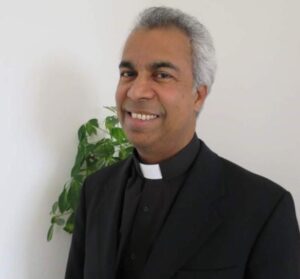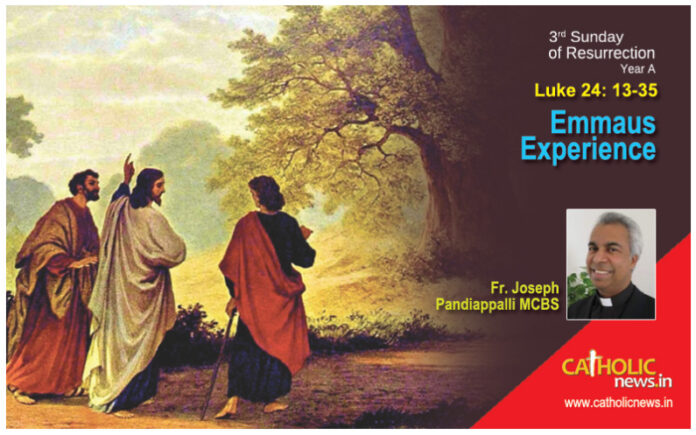
Today we heard in the Gospel reading the story of two disciples of Jesus who travelled from Jerusalem to Emmaus, a village seven miles away from Jerusalem. They came back on the same day to report to the disciples of Jesus about their meeting with the risen Jesus. Before they left Jerusalem they had heard about the resurrection of Jesus and had talked to each other on the way about it, but actually they were not convinced. As they returned to Jerusalem they met the other disciples gathered together and saying: “ It is true! The Lord has risen and had appeared to Simon.”Then these two disciple told them what they had experienced on the way to Emmaus.
According the report of the Gospels Emmaus is around 11.5 Kilometer away from Jerusalem. Although the route is not very short, one could imagine that these two disciple returned on the same day to Jerusalem. Amwas, Abu Gosh and El Qubeibeh are three villages, one which could be Emmaus. Eusabius of Chesaria and Ireneues said in the fifth century that Anwas could be the village mentioned as Emmaus. But Anwas is around 32 KM away from Jerusalem. Therefore it is not thinkable that these two disciples returned to Jerusalem on the same day. Abu Gosch would be possible from the point of view of distance, but it is in another direction with a different tradition. The third one is only around six Kilometer distant. Therefore there is ambiguity and no common agreement regarding the present location of the mentioned village in the Gospel of Luke, Emmaus. Actually this lack of geographical correctness has nothing to do with the content and message of the narration in the Gospel of Luke. The message is that two disciples of Jesus experienced the risen Lord.
The second aspect came to my mind is the question why these disciples could not recognise Jesus immediately. Although the risen Lord walked along with them and spoke to them asking questions and explaining the biblical prophesies the disciples did not recognise him. Perhaps the experience of the disciples about the rised Lord on the way to Emmaus was inaccurate although they had seen, heard and even perhaps touched the Lord as they walked together. But it is appropriate to think that the living Jesus and the risen Jesus are not the same in the sense that the physical body and the risen body are not one and the same. Even Maria Magdeline had not recognised the risen Lord at first sight and considered him to be the Gardner. Even the Apostles could not believe in the resurrection of Jesus until they personally experienced the risen Lord. Even in their case accuracy is missing even if they had seen, heard, touched and even ate with the risen Lord. In that case too it was not the living physical Jesus, but the risen Jesus from the dead, the Christ. It was not like the resurrection of Lazarus whom Jesus raised from the dead, who died again. The resurrection of Jesus was with the risen body who did not die any more. Jesus had told them that he would be with them always. Besides, to experience the risen Lord the disciples needed a grace. It means that it was not self-evident to see the risen Lord, if seen to recognise him even if He moves with us and speak to us.
Even today we are invited to have the grace to recognise the risen Lord, to see him , hear him and to experience him, in prayer or in the liturgical celebration . But to know him and to recognise him we need a special grace and a special blessing. There are many faithful among us who have got this special grace and blessing. We are all invited to have it.
Third question is why Jesus could be recognised by breaking of the bread. We heard in the Gospel that the risen Jesus had spoke with them on the way to Emmaus. That means by hearing the sermon they could not recognise Jesus. Jesus was a preacher during his ministry and had given them an Easter sermon, explaining them the salvation history from the Bible starting with Moses until the preaching of the prophets. In spite of that they did not recognise Jesus. But by breaking the bread and sharing the bread they recognised the risen Lord . A parellel story is the appearance of the risen Lord at the See of Genezareth. The risen Lord invited them for breakfast with bread and grilled fish. About the disciples who went to Emmaus we read the following: “Then their eyes were opened and they recognised him”. That means their eyes were not opened until that moment. That was not the blindness of the eyes or an intellectual blindness, but the blindness of the heart namely an incapability due to their traumatic experience.
“As they approached the village to which they were going, Jesus continued on as if he were going farther,” says the Gospel. “But they urged him strongly, “Stay with us, for it is nearly evening; the day is almost over.” So he went in to stay with them.” The word “ stay with us “ is the same what Jesus told the disciples during his farewell speech. The miracle of recognising the Lord and acknowledging him happens by staying with him. When we stay with him we will recognise him. In other words when the Lord stay with us we will recognise him.
Fr. Joseph Pandiappalli MCBS



